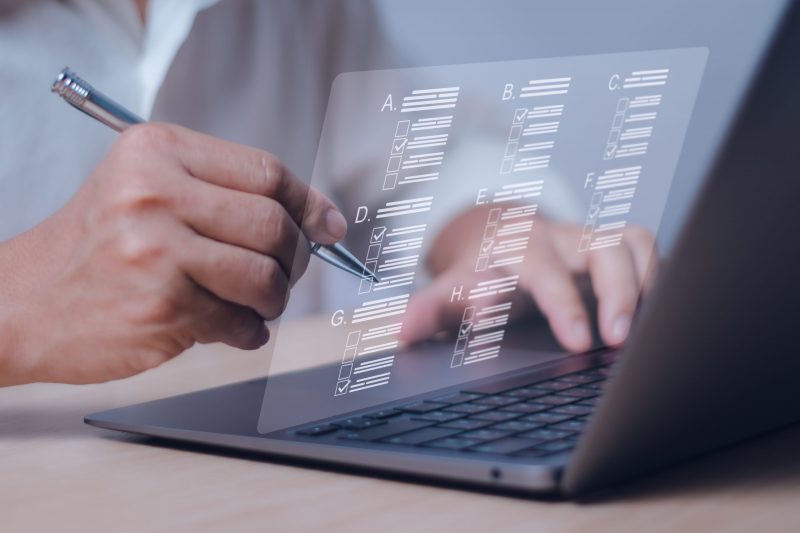Employee assessments are tools similar to surveys that help to measure an employee’s performance, skills, and potential within an organization. These assessments provide a comprehensive snapshot of an employee’s strengths and areas needing improvement. The primary purpose of employee assessments is to support professional development goals and enhance productivity. They help employers identify individual development needs, align employees’ goals with organizational objectives, and make informed decisions about promotions, training, and job assignments. Through structured assessments, organizations can foster a culture of continuous improvement, increase job satisfaction, and ultimately boost their overall performance. These tools are vital in nurturing talent, driving success, and ensuring that each employee contributes optimally to the company’s mission and success.
What Are the Benefits of Employee Assessments?
Employee assessments offer a myriad of benefits for both employees and employers alike. Here’s why these assessments are crucial for evaluation and growth in the workplace:
Objective evaluation
Employee assessments provide an objective means of evaluating an individual’s performance. This can be particularly helpful in situations where personal bias might come into play.
Enhanced self-awareness
For employees, these assessments offer a chance to gain a deeper understanding of their strengths and areas needing improvement. This self-awareness can lead to more effective self-management and professional growth.
Talent identification
Employers can use employee assessments to identify high-potential talent. This is particularly valuable for succession planning and promoting from within.
Performance improvement
By pinpointing areas needing development, employers can implement targeted training and support for employees, leading to improved performance across the board.
Data-driven decisions
Assessments provide data to make informed strategic decisions about hiring, promotions, and organizational development. This ensures that choices are based on solid information rather than gut feelings.
Types of Employee Assessments
There are various types of employee assessments designed for different purposes. Here are six common types of assessments for employees:
1. Performance assessments
Performance assessments are a crucial component of employee management and development that is often conducted annually or semi-annually. These evaluations provide a structured framework for assessing an employee’s job performance and growth. They allow employers to recognize and reward outstanding contributions, identify areas for improvement, and set goals for the future. Performance assessments are vital in decision-making processes related to promotions, salary increases, and individual employee development plans. By analyzing an employee’s achievements and weaknesses, employers can ensure that their workforce is aligned with organizational goals and that employees meet or exceed expectations. This process also fosters open communication between employees and their supervisors, providing a platform for discussing concerns, career aspirations, and feedback, ultimately promoting personal and professional growth within the organization.
2. 360-degree feedback
360-degree feedback assessments offer a holistic perspective on an employee’s performance by collecting input from multiple sources, including their manager, peers, subordinates, and even self-assessment. This comprehensive feedback can provide a well-rounded view of an individual’s strengths and weaknesses. The primary purpose of 360-degree feedback is personal development. It enables employees to gain insights into their interpersonal and leadership skills, allowing them to enhance their abilities and address areas of improvement. By including input from various stakeholders, 360-degree feedback minimizes biases and offers a more accurate assessment. It also promotes self-awareness and helps employees understand how their behavior and actions affect their relationships and effectiveness in the workplace, leading to improved teamwork, communication, and overall performance.
3. Skills and competency assessments
Skills and competency assessments focus on evaluating specific skills, knowledge, and competencies required for a particular job role. These assessments are commonly used during the hiring process to determine if a candidate possesses the essential qualifications and expertise necessary to excel in the position. They can also be employed for current employees to identify skill gaps and tailor training and development programs accordingly. By assessing an employee’s competencies, organizations can ensure their workforce remains equipped to meet evolving job demands. Furthermore, these assessments contribute to more strategic workforce planning, helping organizations understand the strengths and weaknesses of their employees and allowing them to make informed decisions about recruitment, promotions, and succession planning.
4. Personality assessments
Personality assessments, like the Myers-Briggs Type Indicator (MBTI) or the Big Five Personality Traits, delve into an employee’s personality traits, preferences, and work style. These assessments are invaluable for team building, communication enhancement, and ensuring that individuals are placed in roles that align with their personalities. By understanding an employee’s personality, organizations can assemble teams that complement each other and improve collaboration and productivity. These assessments also help employees gain self-awareness and insight into their behaviors and reactions in the workplace. They can identify strengths that can be leveraged and potential areas for development. Personality assessments can improve job satisfaction and performance by matching individuals with roles that align with their natural inclinations and preferences.
5. Behavioral and situational assessments
Behavioral assessments aim to evaluate how employees react in various work-related situations. These assessments are often used to predict an employee’s behavior in specific scenarios, aiding in decision-making regarding promotions or team assignments. The underlying assumption is that past behavior is indicative of future behavior. By analyzing how an employee has handled various situations in the past, employers can make more informed judgments about their suitability for specific roles or responsibilities. Behavioral assessments offer a structured and objective approach to evaluating an individual’s reactions to challenges, conflicts, and stressors, allowing organizations to make decisions that align with their goals and values. These assessments also provide employees with valuable insights into their own behavioral patterns, helping them better understand their strengths and areas for growth.
6. Engagement and satisfaction surveys
Engagement and satisfaction surveys play a pivotal role in understanding and improving the overall well-being of employees within an organization. These assessments measure employees’ emotional investment in their work and commitment to the organization. High levels of engagement are a powerful indicator of a healthy and productive workforce. The surveys often encompass various aspects of an employee’s experience, including job satisfaction, work-life balance, and overall job engagement.
How Do You Utilize Employee Assessments Effectively?
Employee assessments are only helpful if they are used effectively. It’s essential to define clear objectives and align assessments with the company’s goals and values. Communicating these objectives with employees is crucial to ensure they understand the purpose of assessments and feel engaged in the process. The choice of assessment tools and methods should be tailored to the specific needs of your organization, whether it’s performance evaluations, skills assessments, or 360-degree feedback. Feedback from assessments should be constructive, specific, and actionable, focusing on strengths and areas for improvement. Equally important is the establishment of a follow-up plan, incorporating opportunities for training, development, and ongoing support to help employees grow and meet their potential.
Conclusion
Employee assessments are essential for employees and employers to drive professional growth and organizational success. By providing valuable insights into individual performance, skills, and potential, employees can identify and address areas for improvement, set realistic goals, and make informed career decisions. Additionally, assessments allow employers to make data-driven decisions about hiring, promotions, training, and development, ensuring their workforce is equipped to meet evolving business needs. INTOO offers a variety of career development solutions that include assessments along with career coaching to unlock employees’ full potential, increase productivity, and improve performance. To learn more, contact us today.












